Exploring Nature's Palette: The World's Most Colourful Birds
The Most Colourful Birds on Earth
The world is home to many magnificent species of birds, around 10,000 to be exact. Each one is unique and special in its own way, with its own impact on the ecosystem.
However, while this may be true, it’s also true that there’s something special about bright, colourful birds with incredible plumage of all colours.
Animals will often blend into the background rather than stand out to avoid predators, but many bird species continue to display spectacular colourful feathers. However, bright colours are common in tropical birds, where there are bright and bold flowers and foliage for camouflage.
Bright bird colours are not just for show, they help in a variety of ways, including attracting a mate, identification of the same species or sex, and as a warning signal to potential predators.
Keep reading below to see 10 of the most colourful birds in the world – and where to find them!
The spectacular colourful Mandarin duck, but not actually on our top list!
1. Golden Pheasant (Chrysolophus pictus)
With its bright gold colour, there’s no mistaking the golden pheasant! Also known as the Chinese pheasant or the rainbow pheasant, this colourful bird gets in genus name from the Ancient Greek word khrusolophos (with golden crest). Its species name is Latin, from pictus, which means “painted”.
While female golden pheasants are brown or grey, males boast a variety of bright colours. Their backs and heads are a bright, colourful yellow. Their bellies are red. Along the rest of their bodies, they have black, white, and blue markings.
These birds are native to China, but can also be found in the UK, US, Canada, Europe, Australia, South America and more.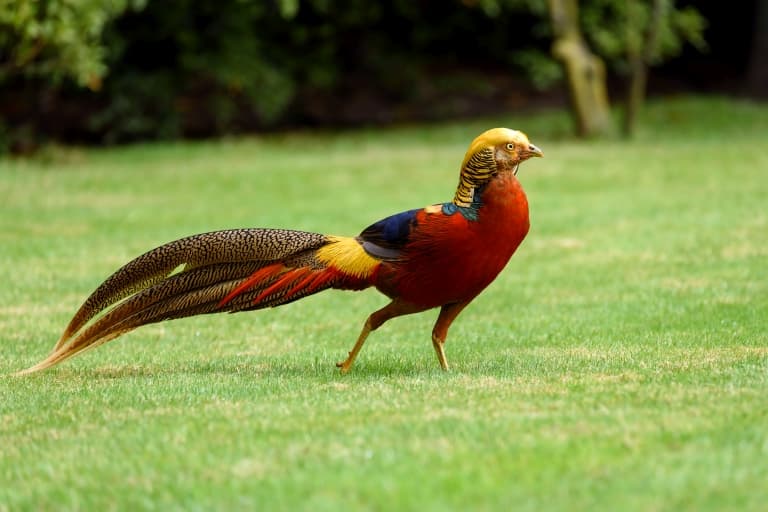
2. Violet Sabrewing (Campylopterus hemileucurus)
The violet sabre wing looks like it’s wearing a cloak made out of gemstones. At first glance, it may appear like an average black bird. However, in the right lighting, you’ll be able to see the iridescent plumage they’re boasting.
Their wings are typically solid black, but the rest of their body is bright green, purple, and blue, all blended together seamlessly! They can be found in Mexico and Panama.
3. Fiery-throated Hummingbird (Panterpe insignis)
The fiery-throated hummingbird is a beautiful, bright bird native to Panama and Costa Rica. They’re in a group of birds known as the “mountain gems” in the family Trochilidae. Like other hummingbird species, the fiery-throated hummingbird is a small bird. Adults only grow up to be around 11 centimetres long, and they weigh less than 7 grams.
From the side, you wouldn’t be able to tell that the fiery-throated hummingbird is one of the most colourful birds in the world. It has a dark blue head that blends into a glittering green body. Their wings are also a dark blue to black colour. It’s the front of their throat that gives them their name.
From the front, these hummingbirds have a bright red throat. It then blends into shades of yellow and blue before eventually meeting the green of the rest of their body. It almost looks like an infrared thermal picture!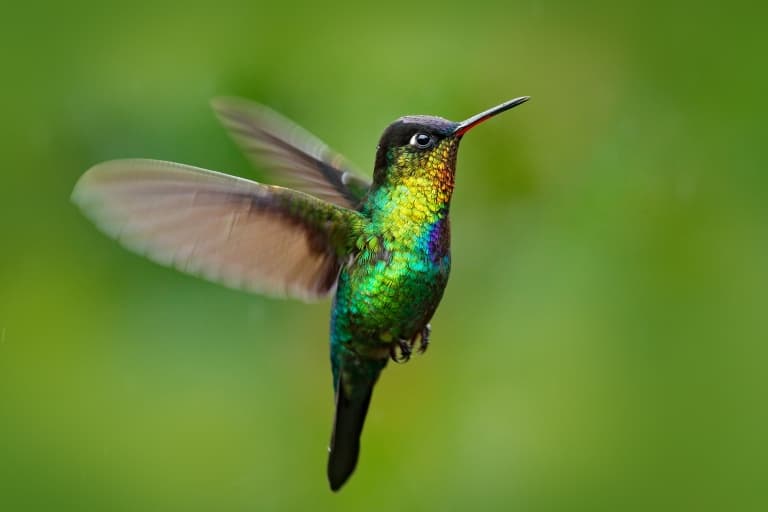
4. Rainbow Lorikeet (Trichoglossus moluccanus)
This little bird doesn’t have the rainbow in its name for no reason!
An Australian parrot, the rainbow lorikeet is one of the most colourful birds. They boast a colourful plumage of greens, yellows, oranges, and blues.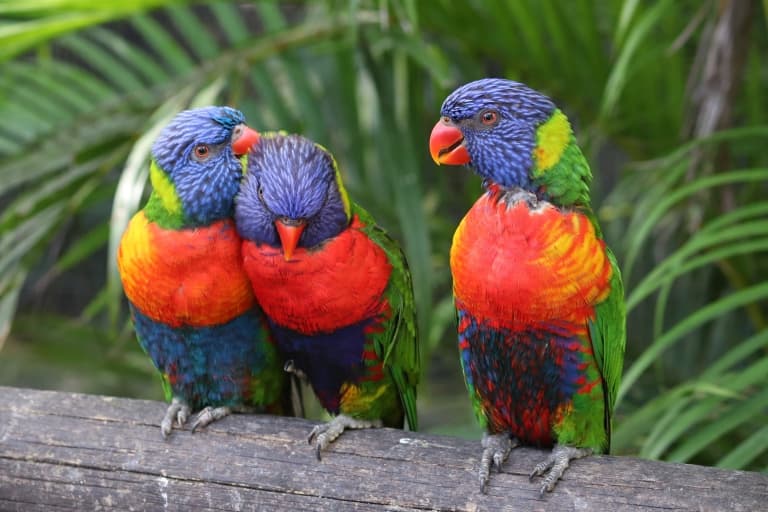
5. European Bee-eater (Merops apiaster)
While this list of most colourful birds has an entire spectrum of colours to show off, few species display nearly every colour the way the European bee-eater does.
They have bright red eyes with black stripes surrounding their eyes, and a duller red on their head. Their wings are orange and yellow, with the yellow blending into their backs and the red of their neck to create a splash of orange there too.
Underneath their neck is more yellow, paired with a white stripe. Beneath their neck, you’ll find a green that blends into their bright blue bellies. The only colour missing is purple, although some areas of their blue feather seem to have a violet tint!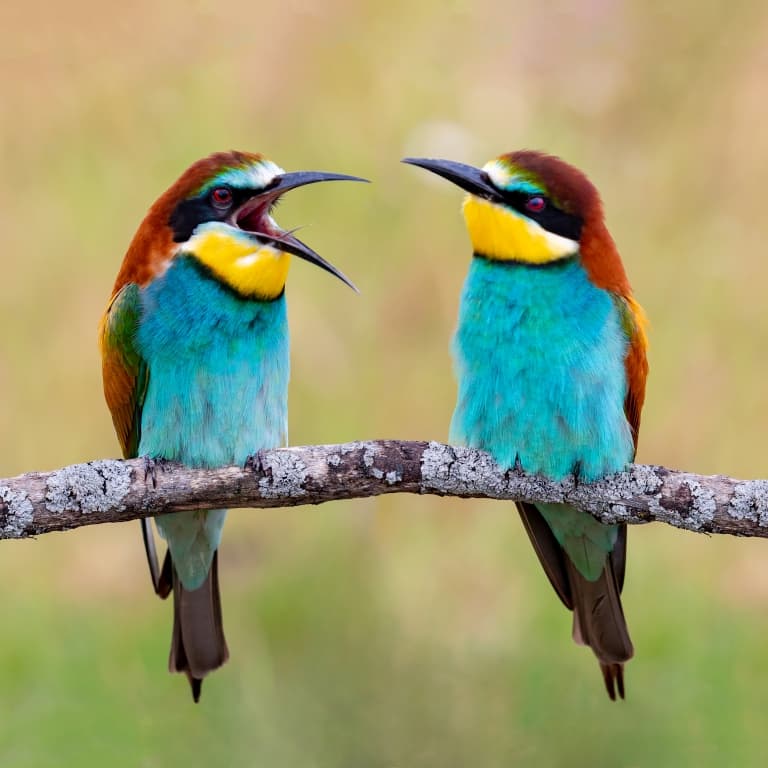
6. Indian Peafowl (Pavo cristatus)
It wouldn’t be a list of the most colourful birds in the world without the Indian peafowl, also known as the common peafowl, the blue peafowl or just the ‘peacock’. Peafowls are large birds, growing to be between 100 and 115 centimetres from bill to tail. They can weigh up to 14 pounds as well.
Male peafowls, or peacocks, are known for their bright, jewel-tone colours. They have bright blue bodies with magnificent feathers that splay out to display a crest of blue and green eye-like patterns.
Their necks, directly under their beak, has a slight greenish coloration that adds to their jewel appearance. This can also appear around their eyes, framed by a large white stripe.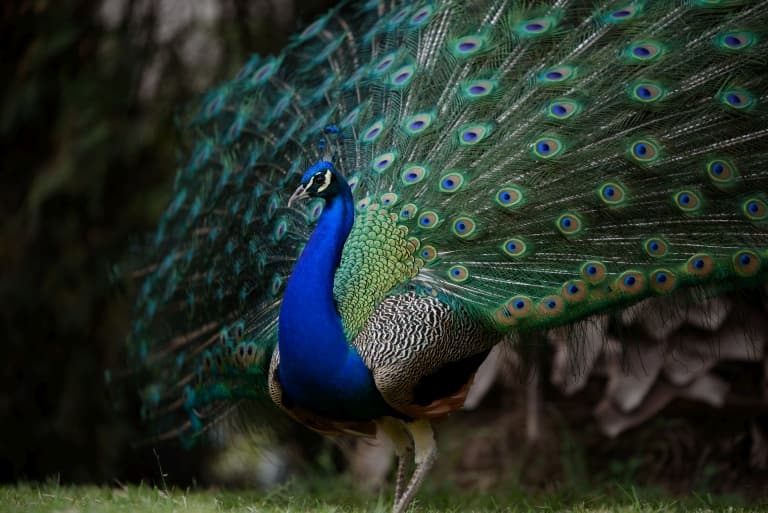
7. Common Kingfisher (Alcedo atthis)
The common kingfish isn’t just known for its long, fish-catching beak. It’s also known for the bright colours it displays!
This bird has a bright blue head and back. Then, its face and chest are a vibrant orange, making them hard to miss.
The common kingfisher is found all over Europe, Asia and even North Africa where it’s a winter visitor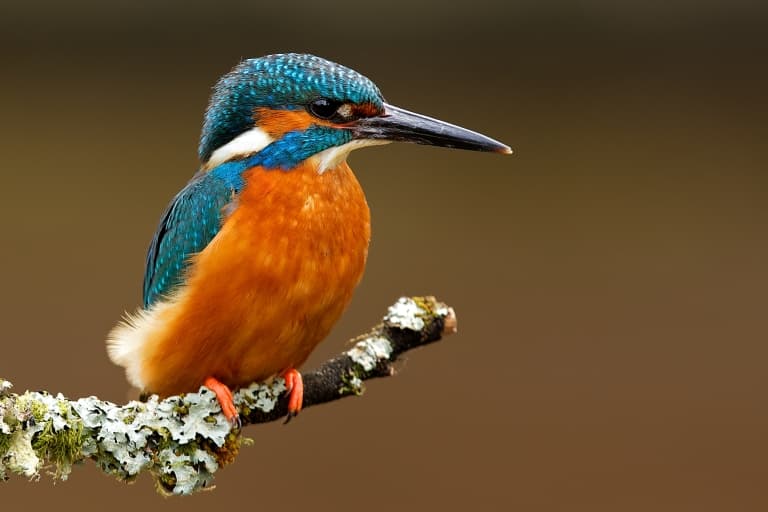
8. Gouldian Finch (Erythrura gouldiae)
The Gouldian finch goes by many names, including the Lady Gouldian finch, Gould’s finch or the rainbow finch. They’re one of the most colourful birds in the world, and they’re found only in Australia.
This beautiful bird was first named in the 19th century by British ornithological artist John Gould in memory of his late wife.
Typically, with birds, the males are bright while the females aren’t. This can be seen in some species such as the northern cardinal and the Indian peafowl. However, this isn’t entirely true for the Gouldian finch. This little passerine is colourful whether it’s male or female. Males, however, are slightly brighter and more colourful.
The Gouldian finch has a patchwork design. From around its eyes to its beak, its a bright red colour. Then, it has a bright blue band that fades into its green neck. Its chest is purple, and its belly is bright yellow. Then, the wings are the same bright green on their neck, and their tail the same blue as their banding.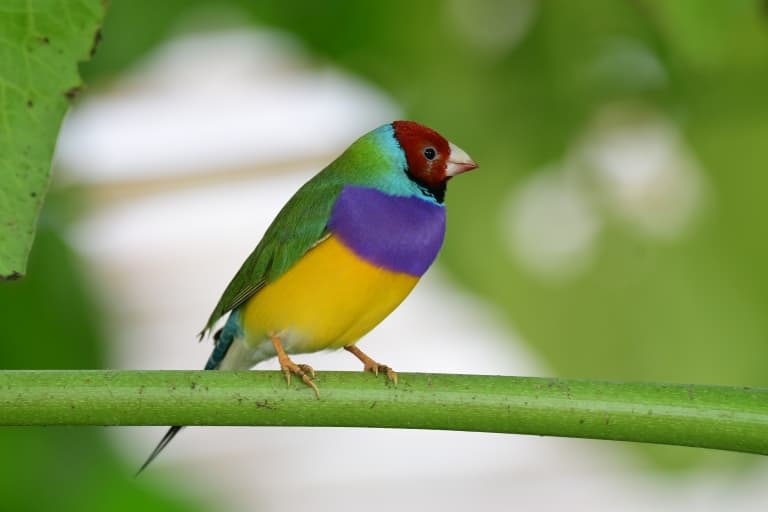
9. Lilac-breasted Roller (Coracias caudatus)
This African bird is named for its bright purple chest. However, that’s not the only colour you’ll find in their plumage. They also sport feathers in a variety of other colours, including blue and green. As juveniles, their chest is a rusty colour instead of lilac.
The lilac-breasted roller are found throughout eastern and southern Africa.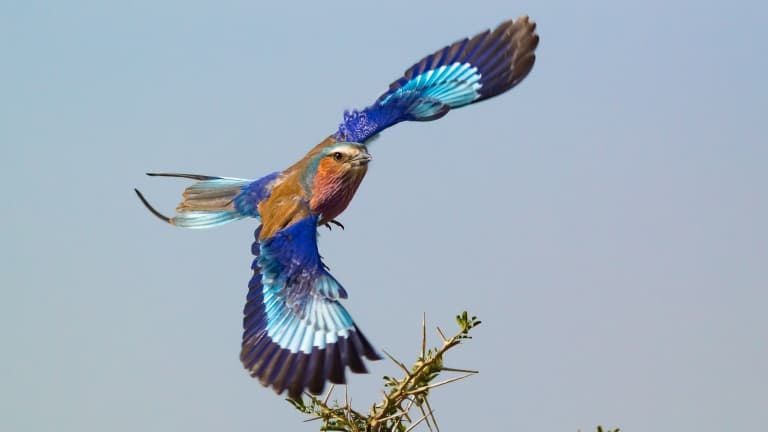
10. Oriental Dwarf Kingfisher (Ceyx erithaca)
The oriental dwarf kingfisher is one of the first birds on this list whose title as one of the most colourful birds can be seen in their beak!
This species of kingfisher has a bright pink or orange bill. The rest of their body resembles a rainbow. They have golden bellies and chests, with blue, green, and purple wings. Their tails and heads are red.
The Oriental dwarf kingfisher are found across much of the Indian subcontinent and Southeast Asia.
Final Thoughts
So, these are our top 10 most colourful birds on earth – but there are plenty more we haven’t included in our list. What birds have we missed?
It’s no exaggeration to say that birds come in every shade of the rainbow. In fact, birds have many ways to create their beautiful hues both through pigmentation and light reflection caused by the structure of the feathers.
Colour can not only help in identification of species, but it can also help identify gender of a bird. Often males and females have different coloration.
For many songbirds, ducks, and hummingbirds, males are typically brighter and more vibrantly coloured than females. Females are often more muted in colour, with neutral tones.
So there’s more to bird colour than meets the eye, although they are beautiful to look at!
Fact Sources
- James McNish (2017), “How did birds become so colourful? Find out“, National History Museum.
- BirdAcademy, “How Birds Make Colorful Feathers“, Cornell University.
References
- Field, Daniel J.; Benito, Juan; Chen, Albert; Jagt, John W. M.; Ksepka, Daniel T. (March 2020). "Late Cretaceous neornithine from Europe illuminates the origins of crown birds". Nature. 579 (7799): 397401. Bibcode:2020Natur.579..397F. doi:10.1038/s41586-020-2096-0. ISSN 0028-0836. PMID 32188952. S2CID 212937591.
- De Pietri, Vanesa L.; Scofield, R. Paul; Zelenkov, Nikita; Boles, Walter E.; Worthy, Trevor H. (February 2016). "The unexpected survival of an ancient lineage of anseriform birds into the Neogene of Australia: the youngest record of Presbyornithidae". Royal Society Open Science. 3 (2):150635. Bibcode:2016RSOS....350635D. doi:10.1098/rsos.150635. PMC 4785986. PMID 26998335.
- Yonezawa, T.; et al. (2017). "Phylogenomics and Morphology of Extinct Paleognaths Reveal the Origin and Evolution of the Ratites". Current Biology. 27 (1): 6877. doi:10.1016/j.cub.2016.10.029. PMID 27989673.
- Kuhl, H.; Frankl-Vilches, C.; Bakker, A.; Mayr, G.; Nikolaus, G.; Boerno, S. T.; Klages, S.; Timmermann, B.; Gahr, M. (2020). "An unbiased molecular approach using 3'UTRs resolves the avian family-level tree of life". Molecular Biology and Evolution. 38 (1): 108–127. doi:10.1093/molbev/msaa191. hdl:21.11116/0000-0007-B72A-C. PMC 7783168. PMID 32781465.
- Crouch, N. M. A. (2022). "Interpreting the fossil record and the origination of birds". bioRxiv. doi:10.1101/2022.05.19.492716. S2CID 249047881.
- Brands, Sheila (14 August 2008). "Systema Naturae 2000 / Classification, Class Aves". Project: The Taxonomicon. Retrieved 11 June 2012.
- Claramunt, S.; Cracraft, J. (2015). "A new time tree reveals Earth history's imprint on the evolution of modern birds". Sci Adv. 1 (11): e1501005. Bibcode:2015SciA....1E1005C. doi:10.1126/sciadv.1501005. PMC 4730849. PMID 26824065.
















































